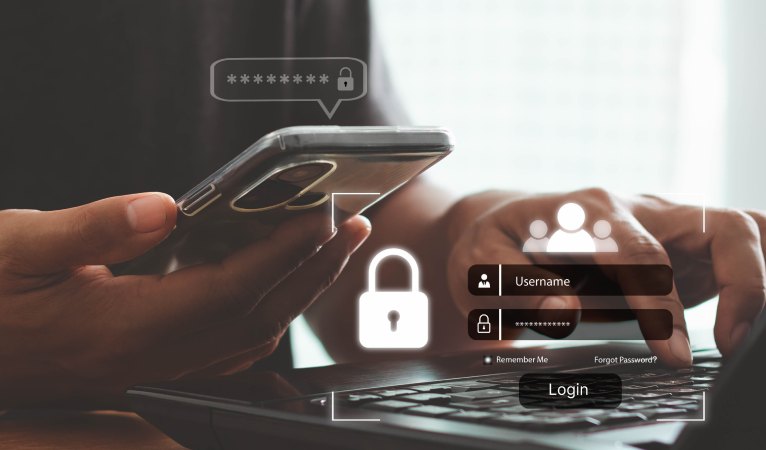Secure Your Accounts with Two-Factor Authentication
Compromised user access is a widely used attack vector to access personal and sensitive information, as well as to put systems at risk. With the vast amount of personal and sensitive data that’s being stored and transmitted online, along with the increasing sophistication of cyber threats, layered security defenses are required to protect the digital assets of individuals and organizations. Two-factor authentication has emerged as a vital online security tool to protect today’s digital landscape.
Using two-factor authentication significantly bolsters access control. This prevents issues stemming from security breaches that can result in issues that range from identity theft and financial loss to significant reputational damage and legal action. Read on to understand how two-factor authentication can be used to defend against unauthorized access, data breaches, and other cyber threats.

Let’s jump in and learn:
- What is Two-Factor Authentication and Why Is It Important?
- What Are Factors in 2FA?
- Risks with Single-Factor Authentication
- Importance of Two-Factor Authentication
- Setting Up Two-Factor Authentication
- Best Practices and Troubleshooting Two-Factor Authentication
- Little Effort, Major Security Enhancement by Implementing Two-Factor Authentication
What is Two-Factor Authentication and Why Is It Important?
Two-factor authentication (2FA) is an access control practice that enhances online security by requiring users to provide two different authentication factors to verify themselves before being granted access to an application or a system. An extra layer of security is added to the basic login procedure (i.e., single-factor authentication, 1FA), which typically only requires a username and password to gain access. This additional verification step ensures that even if the username and password are compromised, unauthorized access to the user’s account can still be prevented.
What Are Factors in 2FA?
In the context of two-factor authentication, factors are based on different types of credentials. Users prove that they are who they purport to be with factors that fall into three categories—something they know, something they have, and something they are. This combination of factors makes it difficult for attackers to steal or fabricate.
1. Knowledge—something the user knows
This factor includes knowledge-based credentials that the user must remember and enter to gain access. Common examples are passwords, PINs (i.e., personal identification numbers), and answers to security questions. This factor is the most basic form of authentication but also the most vulnerable to being guessed (i.e., by brute-force attacks) or stolen (e.g., via phishing attacks, keylogging, data breaches, social engineering, or man-in-the-middle attacks).
2. Possession—something the user has
This involves a physical device or token in the user’s possession that is used to verify their identity. Devices often used for a possession factor include a mobile phone (i.e., to receive SMS codes or an app that generates a verification code), a hardware token, a smart card, or any other device that generates or receives a code. Since this factor requires physical possession of a device, it provides a tough barrier for attackers to bypass remotely.
3. Inherence—something the user is
This factor, commonly referred to as biometrics, relies on the unique biological traits of the user for identity verification. Examples of biometric factors are fingerprints, facial recognition, iris scans, voice recognition, and behavioral biometrics. Biometric authentication is considered highly secure due to the difficulty in replicating or stealing an individual’s biometric traits. However, there are concerns regarding privacy and the risks that come with the handling and storage of biometric data, and biometric protection is becoming more complicated as AI-based technology proliferates.
Risks with Single-Factor Authentication
Single-factor authentication, most commonly implemented as password-based authentication, can lead to security issues, including the following.
Credential stuffing
Attackers use automated software tools to try stolen usernames and passwords on multiple websites. This approach exploits password reuse, where users reuse passwords across multiple websites, services, and applications. A simple example would be utilizing the exact same user name/ password combination to access your business accounts that you utilize for consumer Web sites.
Keylogging and spyware
With keylogging, also referred to as spyware, malicious software can be used to record keystrokes, capturing passwords as they are entered. This allows attackers to steal credentials without the user’s knowledge. Since the user does know the credentials have been stolen, they do not change them, which extends the life of the credentials for attackers.
Password theft
Passwords can be stolen through various means, including phishing attacks, malware, brute-force attacks, or data breaches. Once a password is compromised, attackers can gain unauthorized access to accounts.
Lack of account lockout mechanisms
Without proper security measures like account lockouts after several incorrect attempts, attackers can continue trying different passwords until they succeed (i.e., brute-force attacks), especially when 1FA does not include mechanisms to detect or block such brute-force attempts.
Shoulder surfing
In public spaces, attackers can watch over a user’s shoulder and steal their credentials as they are entered.
Social engineering
Social engineering attacks manipulate individuals into sharing their credentials by exploiting human psychology rather than technical hacking techniques. Social engineering tactics include phishing emails, fake websites, or pretexting via phone calls. Pretexting techniques include phone calls where cyber-attackers purport to be “Help Desk” or “Customer Service”contacts, in order to gain access to users’ private information.
Weak passwords
Users frequently opt for memorable but insecure passwords, making them susceptible to being quickly deciphered. Such passwords, while convenient to recall, are equally prone to prediction. Characterized by their simplicity and predictability, examples of weak passwords include “password” and “123456.” This allows attackers to gain unauthorized access through minimal effort, utilizing straightforward brute-force methods or widely circulated password lists.
Importance of Two-Factor Authentication
Two-factor authentication is of critical importance to provide effective access control. Among the many reasons that 2FA is important are the following.
Compliance with regulations
Many industries and regulations require two-factor authentication to enhance access control for sensitive information.
Cost-effective security enhancement
Two-factor authentication is a relatively inexpensive way to enhance access control, in a significant way. While there may be some initial setup costs with 2FA, cost savings from preventing potential data breaches are much higher.
Defense against a wide range of cyberattacks
Two-factor authentication can protect against various attack vectors by ensuring that a password alone is not enough to breach an account. Even if a user’s login credentials are compromised, an attacker still cannot access their account without the second form of authentication that the attacker is unlikely to have.
Increased trust
When two-factor authentication is implemented, organizations demonstrate that they take security seriously. This can enhance trust in the organization and bolster its reputation.
Lower support Costs
By reducing the likelihood of account compromise, two-factor authentication can reduce support requests related to account breaches and password resets.
Reduced risk of data breaches
Adopting two-factor authentication lowers the likelihood of data breaches by adding a layer of difficulty to unauthorized account access.
Setting Up Two-Factor Authentication
Several steps are required to set up two-factor authentication. The exact setup process can vary slightly between different services, but the following is a general guide on how to set 2FA up that is applicable to most services that offer it.
1. Access security settings
- Log into the account where two-factor authentication is to be enabled.
- Navigate to the account or security settings where options for enhancing security are listed.
- Find the section related to security, privacy, or login. This is often found in the “Settings” or “Account” section.
2. Select the two-factor authentication option
- Look for a section labeled two-factor authentication, 2FA, multi-factor authentication, MFA, extra verification, or something similar.
- Click to initiate set up.
3. Choose a second factor
Most services offer a choice of second factors, such as:
- Authenticator applications (e.g., Google Authenticator or Authy)
- Biometric verification (e.g., fingerprint, retinal scan, or facial recognition)
- Physical security keys (e.g., hardware token or smart card)
- Text message (SMS) or email codes
4. Follow setup instructions and verify the second factor
As noted above, the exact process may vary, but the following are a few examples.
- For authenticator apps, users scan a QR code with the app, which will then start generating login codes.
- For biometrics, users register their fingerprint or facial data as instructed.
- For physical security keys, users engage the device and then follow prompts to register it with their account.
- For SMS and email, users enter their mobile phone number or email address, then verify it with a code that is sent to them.
5. Select and set up backup options
Establish backup access options in case the primary two-factor authentication method is unavailable. This is often a backup code, an alternative phone number, or a secondary email address.
6. Confirm activation
After the second factor has been successfully entered, two-factor authentication should be enabled on the account. Some services ask users to enter a backup code or set up a backup method to confirm that all activation steps have been completed.
7. Test two-factor authentication
Try logging out and logging back in to ensure the two-factor authentication process works as expected. If it is working correctly, the user should be prompted for their second factor after entering their login credentials.
Best Practices and Troubleshooting Two-Factor Authentication
Implementing best practices and knowing how to troubleshoot common two-factor authentication issues will help maintain secure and efficient access to accounts that use 2FA. The following are several commonly cited best practices and troubleshooting tactics:
Educate users
Ensure that users understand how two-factor authentication works and educate them about its importance. Awareness significantly improves the adoption and proper use of 2FA. Users should also be educated about phishing attacks, including what they are, how they work, and how to detect them to avoid falling for the trick.
Regularly check recovery information
Make sure that recovery phone numbers and email addresses are up to date to ensure access if the primary two-factor authentication method is not available.
Use authenticator apps
Where possible, use an authenticator app, such as Google Authenticator or Authy, rather than SMS-based two-factor authentication. These apps are considered more secure for 2FA because they do not rely on users’ phones, which are vulnerable to SIM swap attacks and require a cellular connection to receive codes.
Use a dedicated device
If possible, use a dedicated device for receiving two-factor authentication notifications. This isolates the second factor from potential threats that might compromise the primary device. A physical security key offers enhanced security as a second factor.
Troubleshooting Two-Factor Authentication
When having issues with two-factor authentication, several areas to check are:
- Error messages
Look for any error messages, as these can often provide a guide to resolving the two-factor authentication issue. - Network connection
If SMS or email codes are not arriving, confirm that the device has a stable internet or cellular connection. A weak signal could prevent the two-factor authentication code from being delivered. - Time settings on the authenticator app and device
If an authenticator app is being used, make sure the time on the device is in sync with the app’s clock. Time discrepancies can cause the generated codes to be out of sync.
Several common two-factor authentication issues and steps users can take to resolve them are:
- Backup codes not working
Check that the backup codes are entered correctly without spaces or typos. If they still are not working, they might have been reset or disabled. In this case, check if there is a way to generate new ones in the account settings. - New phone or device setup
Remember to set up authentications on a new phone or device and if a new authenticator app is used. When accounts are transferred to a new device, some services require users to disable two-factor authentication and re-enable it using the new device. - Not receiving SMS or email codes
If a request has been sent for an SMS or email code and it failed, try resending it. Often, it is caused by a faulty connection or a temporary issue with the phone network. - Receiving two-factor authentication requests that were not user-initiated
If a user receives two-factor authentication prompts without trying to log in, someone might be attempting to access their account without authorization. The password and security settings should be reviewed immediately. If a support team is available, they should be contacted immediately.
Little Effort, Major Security Enhancement by Implementing Two-Factor Authentication
Users are considered one of the weakest links in security systems. When only basic credentials are required for users to gain access to digital resources, organizations are at heightened risk for successful cyberattacks. This is because the protection of these basic credentials is based on user behavior, which is unreliable.
Implementing two-factor authentication enhances access security and is a relatively easy process that provides an excellent return on investment. Using 2FA can drastically lower the chances of security breaches that can expose sensitive information, leading to a range of challenges for an organization, ranging from legal issues to reputational damage. A two-factor authenticator is widely considered a must-have for all organizations and users.
Egnyte has experts ready to answer your questions. For more than a decade, Egnyte has helped more than 17,000+ customers with millions of users worldwide.
Last Updated: 19th April, 2024


